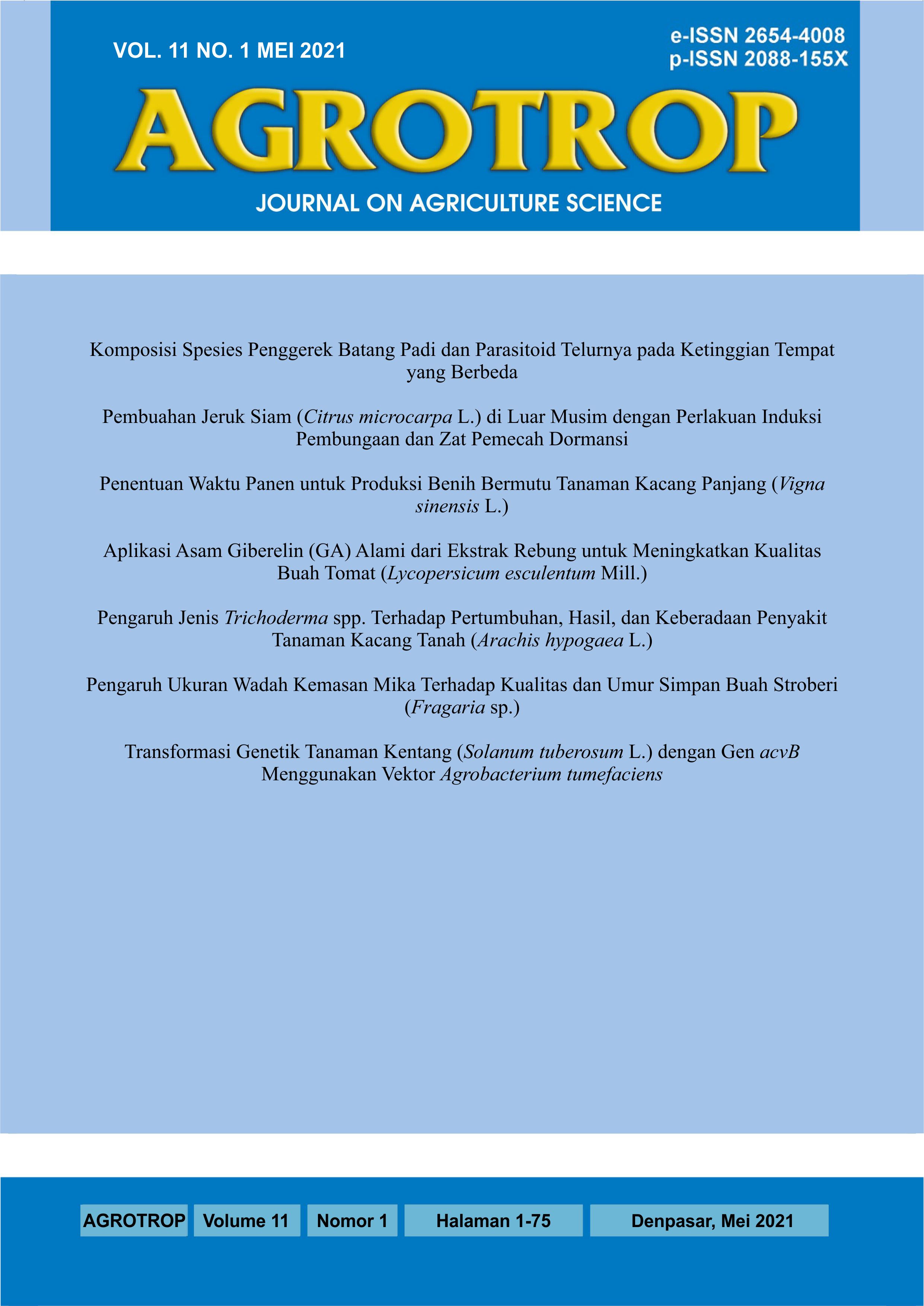Komposisi Spesies Penggerek Batang Padi dan Parasitoid Telurnya pada Ketinggian Tempat yang Berbeda
Abstrak
Composition of Rice Stem Borer Species and Their Egg Parasitoids at Different Altitudes. Rice stem borer is one of the main pest of rice plants that always percolating and attack plants in the field. The pests can result in damage to plants and lost of the grain from season to season. The aim of this research is to know composition and dominance rice stem borer species and role of their eggs parasitoid at an altitude of different places. Research is done by survey based on the height of different altitude in rice plants two weeks after cropping up until eleven weeks after planting. Research conducted from April until August 2019 in rice field that belonging to farmers at Subak Cemagi Let, Cemagi Village and Subak Teba, Mengwi village, Badung regency, Bali province. Subak Cemagi Let are at an altitude of 15 meters above sea level whereas Subak Teba are at an altitude of 300 meters above sea level. Identification of Rice stem borer larvae and their eggs parasitoid done in Pest Laboratory, Agriculture Faculty of Udayana University. Found three species rice stem borer in the height 15 mdpl namely Scirpophaga incertulas; Sesamia inferens dan Chilo suppressalis, whereas in the height 300 mdpl found four species namely Scirpophaga incertulas, Sesamia inferens, Chilo suppressalis, dan Chilo polychrysus. S. incertulas was the most dominant at the two different altitude. Three species of eggs parasitoid that have role to suppress the development of rice stem borer at the different altitude namely Tetrastichus schoenobii, Telenomus rowani dan Trichogramma japonicum. T. schoenobii was the most dominant to suppress rice stem borer populations.
##plugins.generic.usageStats.downloads##
Referensi
Kalshoven, L. G. E. (1981). The Pests of Crops in Indonesia L.G.E.Kalshoven; Revised and Translated by P.A.Van Der Laan. PT. Ichtiar Baru-Van Hoeve.
Kartohardjono, A. (2011). Penggunaan Musuh alami Komponen Pengendalian Hama Padi Berbasis Ekologi. Pengembangan Inovasi Pertanian, 4(April 2009), 29–46.
Makarim, A. K., Widiarta, I. N., Hendarsih, S., & Abdurachman, S. (2003). Panduan teknis pengelolaan hara dan pengendalian hama penyakit tanaman padi secara terpadu. Puslitbangtan.
Nishida, T., & Torii, T. (1970). A handbook of field methods for research on rice stem-borers and their natural enemies (IBP handbook no. 14). Davis.
Siwi, S. S. (1979). Identifikasi Penggerek Batang Padi Di Indonesia. Kongres Entomologi I Jakarta.
Soejitno, J. (1984). The Biological Aspects of Egg-Parasitoids of Rice Stemborer. Dalam Sosromarsono. S. et al. (Ed.), Symposium on Biological Control of Pests in Tropical Agricultural Ecosystem.
Suharto, H., & Sembiring, H. (2007). Status Hama Penggerek Batang Padi di Indonesia.
Suharto, H., & Usyati, N. (2009). Pengendalian Hama Penggerek Batang Padi. Balai Besar Penelitian Tanaman Padi.
Wijaya, I. N. (1992). Serangan dan Musuh Alami Penggerek Batang Padi pada Persawahan Tanam Serentak dan Tidak Serentak di Kabupaten Badung, Provinsi Bali. Institut Pertanian Bogor.
Wijaya, I. N., & Adiartayasa, W. (2015). Serangan Penggerek Batang Padi dan Peran Parasitoid Telurnya dalam Mengendalikannya.











